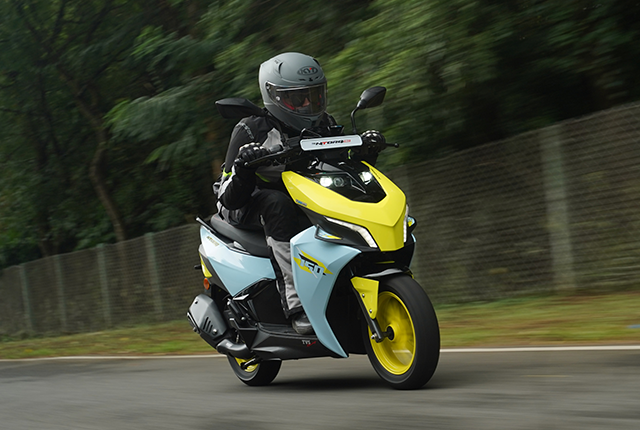The trusty old Ntorq has been blessed with a bigger, badder 150-cc engine. But will TVS’ most powerful scooter yet be able to rizz up the GenZ riders and draw them into its fold?

Story: Abhisu Poddar
Photography: Kalidas M
The “sporty scooter” genre has only recently seen a rise in demand, with sales charts showing a northward trend every financial year. Naturally, every manufacturer now wants a piece of the action, while the youngsters demand a scooter that’s fast yet efficient, nimble yet stable, masculine yet unisex—in short, a bit of everything, just like the generation they belong to. TVS has had the formula locked down, with the Ntorq 125 topping sales charts consistently since 2022. But with bigger boots to fill, it was time for the Ntorq to grow bigger legs too.
TVS has done just that with the new Ntorq 150. Targeting newly employed youngsters who have outgrown their faithful college chariot (read Ntorq 125), the designers at TVS have tried their best to make it visually distinct from its sibling despite sharing the same chassis and main frame. Inspired by the Graphite concept and “stealth aircraft” design, the arrowhead-shaped apron houses a quad LED projector headlamp cluster. The daytime running lights (DRL) and indicators share the same unit, flanked by small winglets which, TVS claims, add aerodynamic weight at the front. Loud and energetic colour schemes complete the package, though the design may divide opinion.
The newly developed air-cooled, three-valve, 149.7-cc engine produces 13 hp at 7,000 rpm and 14.2 Nm at 5,500 rpm. Essentially an expanded 125-cc mill, it has also gained a lightweight crankshaft and oil-cooler. You can choose to put this newfound power down via two ride modes: Street mode enables idle start-stop, while Race mode uses the iGO assist micro-hybrid system to provide an electric boost on acceleration. Power is channelled to the rear wheel via a belt-drive continuously variable transmission (CVT), with traction control and a single-channel anti-lock braking system (ABS) aiding safety.
Well, what’s the outcome? On track, the scooter pulls cleanly from a standstill with minimal power loss felt in the transmission. Throttle response is impressively crisp and obedient, with a flat torque slab available through the low and middle range. However, while the Ntorq 150 feels noticeably quicker than the 125, the sense of rush or urgency expected from a larger displacement engine feels a touch diluted. Speed builds up in a linear manner up to 90 km/h before tapering off. We managed to clock 108 km/h on the speedo, slightly above TVS’ claimed figure of 104 km/h, though GPS testing will confirm the true figure. The engine note is bassier and deeper than the 125’s, though more vibration is felt at idle. Thankfully, it fades away once on the move, keeping away even at higher speeds.
As for the chassis design, carry-overs include the Ntorq 125’s main frame and 12- inch alloys (from the XT), shod with Eurogrip Remoras. A 14-inch setup would have been welcome in terms of stability and road-handling, but the 12-inch wheels provide decent agility while remaining predictable. Grip from the tyres and chassis are reasonably good, and the scooter leans in and sticks to the desired line across a corner cleanly with minimal drama. The suspension is on the firmer side, allowing the scooter to corner confidently, brushing off dips and patches without much of a hassle. Of course, its real-world road manners remain to be seen.
The chassis feels planted and masks speed surprisingly well. Despite its smaller wheels, the Ntorq cruises along effortlessly at higher speeds. While cooling down after repeated heated runs up and down the track, I caught myself relaxing with my back upright and left hand dangling by my knee, while still doing 100 km/h effortlessly. Overall, the chassis complements the engine really well, and the Ntorq 150 should be quite amenable to longer rides. The 220-mm front disc and 130-mm rear drum do an excellent job of slowing the scooter down, with progressive bite and ample feedback through the levers. The hazards flash during panic braking, notifying the nearest tailgater that it’s time to bite the pillow. Neat stuff that.
Now, from the rider’s point of view. Right from the moment you mount the 770-millimetre-tall saddle, you realise that the Ntorq 150 is a roomy scooter. The flat, grippy floorboard gives it a utilitarian edge over some of its contemporaries, and should keep your feet and small items in place during daily commuting. The 22-litre under-seat storage is adequate, if not class-leading, and a two-litre front glovebox adds some practicality.
The touchpoints of the Ntorq 150 are a strong example of trickle-down economics; the 5.0-inch colour TFT display and the switchgear all look suspiciously similar to the Apache RTR 310’s. Turn the key, and you are greeted by a high-resolution gaming-inspired user interface that’s simple and intuitive to read. All points of contact feel top quality, with both brake levers getting three-step adjustment and a handy brake-lock latch.
Overall, the scooter is impressively built, with the plastic panels and paint exuding premium quality and durability. The fit and finish is tight, the panels all line up evenly with no visible upsets or gaps and the switches operate flawlessly with tactile confidence.
On TVS’ private test track in Hosur, we got to assess only a part of the Ntorq 150’s personality. While it is quite peppy and agile in its own right, the “hyper-scooter” exudes more sportiness visually than it does in terms of outright performance. I feel a little more rawness and a punchier power delivery would have provided the edge this scooter needs to stand out in the 150-cc class. That said, it still promises plenty once unleashed on public roads, so we will reserve our final impression until then. For now, we are impressed by what we’ve seen for the price, and buyers in the 150-cc scooter market would appreciate the zap without compromising on the commitment.


Leave a Reply